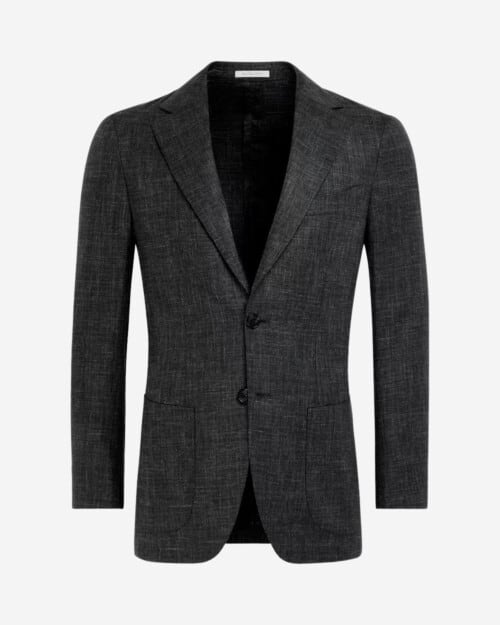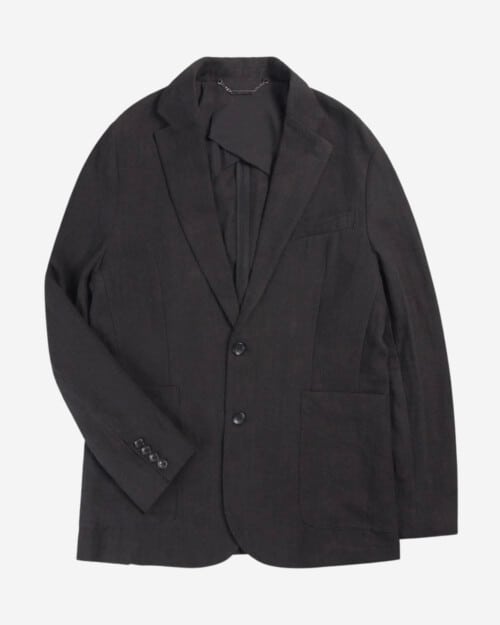The Ultimate Guide To Men’s Unstructured Blazers
The unstructured blazer is a smart-casual must-have. Here's everything you need to know before you buy, including the best brands and key details to consider.
Forget any notions of tailoring being stuffy and old fashioned. The unstructured blazer puts all of that to bed. This soft, comfortable jacket is many things the traditional suit isn’t, and it’s all the better for it. Indeed, if you’re after a smart yet easy and versatile tailored look, you need an unstructured blazer.
Cut with little to no padding in the shoulders and chest, it strips much of the formality away, leaving a garment that can be dressed up with pleated trousers, shirts and ties, or down with jeans and sneakers. And it’ll look great every time.
Still unsure? From the reasoning behind their ever-increasing relevance today, to purchasing considerations and how to wear them, consider this the ultimate guide to the unstructured blazer.
What is an unstructured blazer?
Traditionally, suit blazers come with a lot of padding. Pick up a jacket off the rack in any retail store and chances are it will have wadding in the shoulders and some form of chest canvassing. This gives the jacket shape, with the idea being that you put it on and take on a heroic, ‘masculine’ silhouette with broad shoulders, a powerful chest and nipped in waist.
This is certainly how British tailors have made their name, with those on Savile Row perfecting the ‘roped’ shoulder, called as such due to its rope-like padding which gives it its distinctive sharp lines that many deem desirable.
Most formal suits are made like this. Yet with that tradition comes plenty of fusty connotations, with heavily structured tailoring often looking staid and a bit old fashioned. The unstructured blazer is the antithesis of this. Cut with little to no padding in the shoulders and chest, the result is a more natural look with flowing lines. Whereas structured tailoring shapes the wearer, creating the illusion of a strong physique, unstructured tailoring moulds to your body, giving off softer, more relaxed air.
Because of their comfortable build, unstructured jackets are particularly useful for the warmer months. They work particularly well rendered in lightweight cotton, linen blends and seersucker, creating jackets that look smart but are nearly as comfortable as knitwear.
Put on a traditional jacket and you feel it prodding and guiding you, forcing your body into a rigid stance. Try an unstructured blazer though and it’ll feel like your favourite cardigan.
Why unstructured blazers are more relevant than ever today
There are no two ways about it, traditional tailoring has less of a place in modern society today. Sure, there are still industries where seriously sharp lounge suits are needed, but it’s no longer common practice for the majority to wear them to work.
Plus, people care more about comfort nowadays. Whereas in decades gone by many will have sacrificed comfort for formality, today, staying comfortable is the number one priority for most. These two factors – dress codes dwindling and placing more importance on comfort – means that unstructured tailoring is more relevant than ever before in 2024.
Think about it for a second. Why would you wear something with lots of padding and structure, when you can wear a blazer that looks put together and professional, but with none of the stuffiness? Unstructured blazers still look sharp, after all. Try one and there’s no mistaking you’re wearing a tailored jacket. But the softer shoulders, lighter fabrics and more comfortable fits ensure they look and feel far less restrictive.
Who they suit
If you’re not sure whether an unstructured blazer will suit you, you’re in luck. The soft cut works for all manner of body styles, from muscular and athletic through to wider or shorter figures. The trick is to not go too slim.
Overly slim unstructured jackets aren’t flattering for anyone, and will make you look far shorter than you actually are. Instead look to relaxed tailored cuts that allow for a bit of drape and movement with the fabric. Unstructured jackets shouldn’t be too long, with the hem ideally finishing below the wearer’s behind, but a bit of length is necessary to allow the jacket to ‘hang’ correctly.
This is especially true for muscular men. Getting an overly slim unstructured jacket is the upper half equivalent of skinny jeans. We get it, you work out. But there’s a big difference between looking strong and powerful and like you’ve been wrapped in sausage casing.
Jokes aside, go too slim and ironically it won’t flatter your guns; it will just make you look chunky and like you’re trying too hard.
Why you need an unstructured blazer
If you’re still not convinced, allow us to try one last time. The unstructured blazer is arguably the most versatile piece in your smart-casual arsenal. Whether you need a jacket for the office, a first date or a summer wedding, an unstructured blazer will have your back, while remaining comfortable and light against the body.
Pick one in a mid-weight cotton and it can be worn throughout the year, while linen blend or seersucker examples are ideal for the hotter months, combining well with chinos or tailored trousers as part of a separates look.
If you seek comfort and ease of wear, and you’re going to buy just one blazer, make it an unstructured version. You won’t regret it.
What to consider when buying an unstructured blazer
How it fits
As previously mentioned, unstructured blazers shouldn’t be cut too slim. You should be able to comfortably button it up, with no pulling across the waist or chest, while the arms should allow for plenty of movement whether sat down or walking.
The shoulder hems should finish at the end of your own shoulders, while the arms should end just before the beginning of your wrists, allowing an inch of shirt cuff to be visible underneath. The jacket hem should cover the wearer’s behind, and the jacket’s waist should also nip in slightly, creating a soft hourglass silhouette.
It’s advisable to spend as much as you can on a tailored jacket, with bespoke options offering the best fit, made-to-measure second best and ready-to-wear after that. There are plenty of good options for the latter, with main street brands such as Reiss and Suitsupply specialising in soft tailoring cut from high-quality cloths.
Finer details
There are a number of details to keep an eye out for with unstructured tailoring, the most important being the lapels, pockets and button configuration.
For ultimate versatility, you’ll want to prioritise notch lapels. For those that don’t know, these are exactly as you would expect: the lapel has a little notch in it. The alternative are pointed peak lapels. The latter is considered formal, while the former is more understated and better suited to the laid-back nature of a softly structured jacket.
When it comes to width, a regular notch lapel should be around 3-3.5 inches at its widest point. Anything outside of that boundary tends to look a little strange, whether skinnier or wider.
Patch pockets tend to suit this type of jacket best. They are more Neopolitan in style, giving off that relaxed, sophisticated air that Italians seem to ooze. Flap and jet pockets meanwhile can appear a little too business-like, which is the vibe we want to avoid.
Finally, a two-button front is the most flattering option for the majority of men. Just remember to leave the bottom button undone to allow the jacket to move properly. Double-breasted unstructured blazers can also work, and give a slightly more put together, formal look versus single-breasted, but they need to be worn with confidence and suitably smart trousers.
The best unstructured blazer brands
Blugiallo
Blugiallo bills itself as the place where fast fashion has come to die. Which is another way of saying it’s meticulous, precise and – yes – slow in the way it goes about making clothing. Its unstructured jackets are a good example. Made to measure, but with a modern twist, you fill in your measurements online and the label creates a fit profile that’s all yours. It then makes your blazer exactly how you need it.
The brand is Swedish, with plenty of French and Italian influence in its collections. And from that fusion come blazers that as understated and elegant, casual and comfortable.
Sunspel
Shorthand for beautifully crafted British menswear, Sunspel has been producing insanely soft clothing since the 1860s. It might be better known for impeccable T-shirts, knitwear and boxer shorts, but the label also crafts excellent smart-casual tailoring.
Its unstructured blazers are lightweight but generously proportioned and come in a handsome collection of colours and fibres. Pair one of its feather-light linen jackets with a Breton top underneath for a suave take on the British summertime.
L’Estrange
L’Estrange is all about Goldilocks menswear – never underdressed, never overdressed, just right. If you’re wondering what ‘just right’ looks like for this eco-conscious London brand, it’s a tight, carefully designed capsule wardrobe that works for practically anything a modern urban lifestyle might throw at you.
In that mix, an unstructured blazer is a fine, versatile addition. L’Estrange’s 24 Blazer comes in wool, linen and stretch cotton. Soft at the shoulders and a little more fitted through the body, it’s a perfect day-into-night layer that works just as well for business-casual offices as it does for dinner dates and even weddings.
Wax London
Wax London is another young British label to make an impression in recent years with playful takes on menswear staples. Its unstructured blazers are more conservative than its more casual pieces but this is never going to be a jacket to peacock in.
Think slimline linen blazers, discrete patch pockets and a notch lapel. Lightweight and breathable, it’s the kind of blazer you can wear with a T-shirt just as easily as a more formal button-up.
Suitsupply
Suitsupply is among the very best of the mid-price tailoring brands. It only works with the finest cloth mills and specialises in Italian-inspired cuts. So expect plenty of unstructured jackets that are designed to be soft and comfortable while looking effortlessly cool.
Check out its Lazio blazer, which comes with shirt sleeve shoulders and is available in a variety of beautiful fabrics ranging from cashmere and linen to silk blends.
Reiss
Reiss has long championed the unstructured suit, with its contemporary blazers among the best value designs you’ll find. The British brand has experimented with fashion-forward cuts in the past, but all in all tends to stick to classic cuts.
Look out for its seasonal selection of blazers, which are cut from lightweight, breathable fabrics and nearly always feature soft shoulders and shorter silhouettes.
Paul Smith
Paul Smith started out as a relatively formal menswear shop. While it has branched out into a global fashion powerhouse, the brand’s roots can always be found in its tailoring section.
You can therefore expect to find a range of cuts, which tend to fall on the slimmer, more contemporary side of the suiting spectrum.
In the spring and summer months look out for its unstructured jackets, which typically come with interesting details such as colourful inseams or contrasting pocket linings.
GANT
If you’re looking for unstructured blazers with a preppy, all-American slant, Gant is well worth considering. The US brand made its name off the back of its excellent Oxford shirts and chinos, but its tailoring is just as good.
Within its collection you’ll find a variety of relaxed, smart-casual blazers that reference America’s tailoring past.
Percival
Percival is best known its sublime knitwear, with the knitted polos and embroidered garments proving especially popular season after season.
And its tailoring range offers the perfect smart-casual foil for these everyday pieces, with a wide range of unstructured the blazers made from soft cotton- and linen-blend fabrics as well as more rugged wools and flannels.
Oliver Spencer
Taking inspiration from the worlds of workwear, tailoring and streetwear, Oliver Spencer’s collections are equal parts sharp and relaxed. The label has one of the most comprehensive collections of unstructured blazers you’ll find.
While most brands stick to a simple two-button silhouette, Oliver Spencer also creates single- and triple-button designs, as well as double-breasted blazers and nehru jackets. Softly cut across the board, they’re typically cut from cotton and wool sourced from British mills.
Ralph Lauren


Ralph Lauren almost single-handedly propelled preppy clothing into the mainstream, with the brand’s luxury polos, Oxford shirts and chinos being instantly recognisable anywhere around the world.
When it comes to tailoring, you can expect a similar level of quality, with soft, unstructured jackets and pleated trousers becoming mainstays in its seasonal collections.
It’s hard to pick fault with the brand’s chino suits, which are cut from a beautiful soft cotton with a hint of stretch. Expect a natural shoulder line and a comfortable, slim fit that works as a suit or broken up into separates.
Muji
Muji is one of the most underrated clothing retailers in business today. While you might first visit its stores for its interesting homeware or exceptional candles, you’ll stay for its menswear.
Its curated range consists largely of well-made basics, which are nearly always cut from innovative, lightweight fabrics. One of its latest ranges comes in a 100% hemp material, which is similar to linen with its breathable, textured finish.
Its unstructured jackets are offered in relaxed fits designed for a loose, breezy aesthetic that’s both stylish and incredibly comfortable.
Thom Sweeney


If you’re looking for the ultimate unstructured blazer, head to Thom Sweeney. The British tailoring house specialises in soft, Italian-inspired cuts that make use of the world’s finest fabrics from mills such as Loro Piana.
The brand’s house cut features soft shoulders, a slim body that’s follows the lines of the wearer and a lack of structure in the chest for a natural, comfortable appearance.
Keep an eye out for seasonal takes on both single- and double-breasted tailoring, or keep it classic with one of the brand’s signature navy jackets.





































